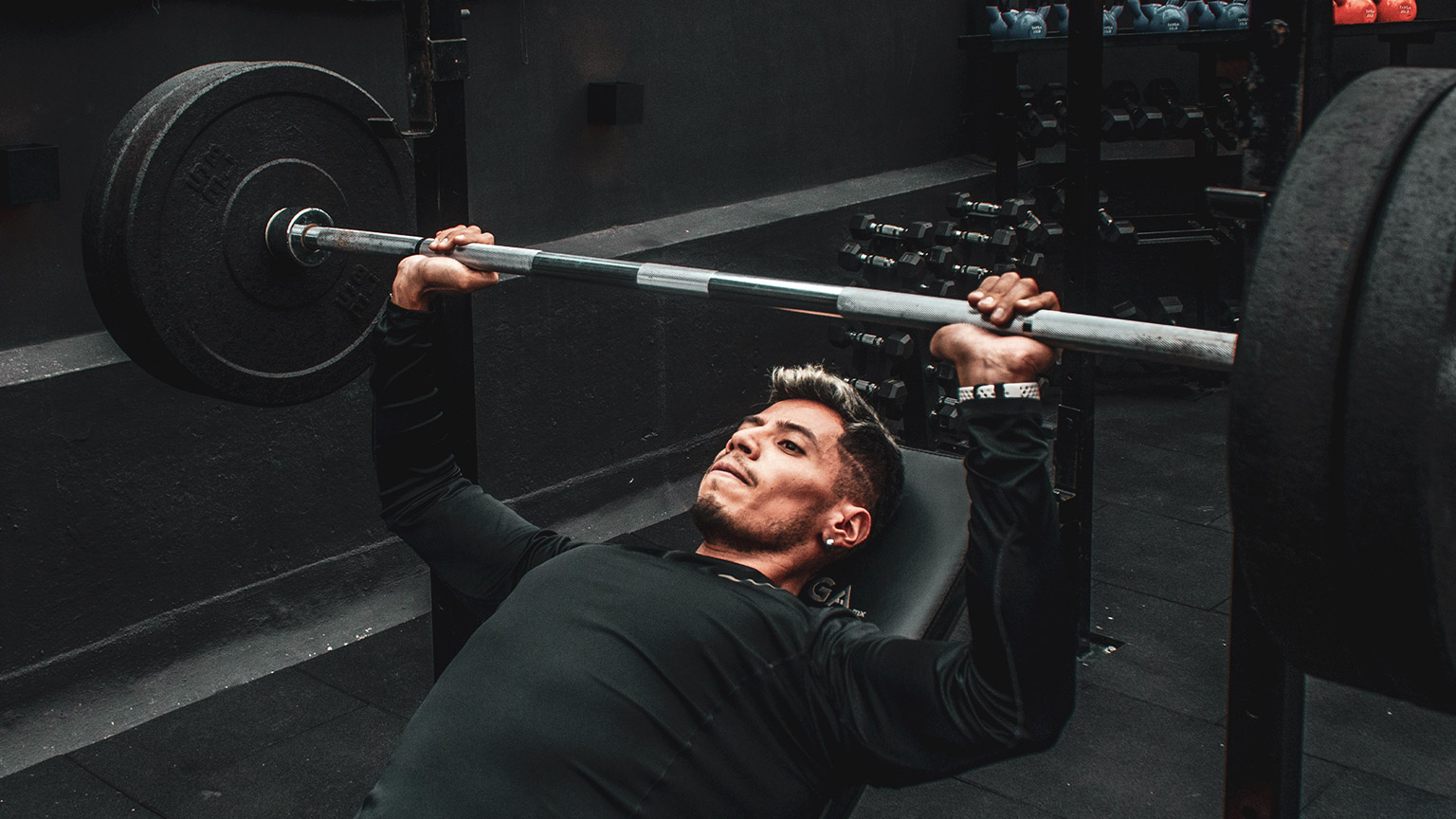In this topic, we concentrate on the upper body. You will learn how to perform and teach clients 18 specific exercises listed in the following table:
| Bench press | Pec deck | Lat pulldown |
| Machine bench press | Overhead/shoulder press | Seated row |
| Chest press | Front raise | One-arm row |
| Push-ups | Lateral raise | Bent over row |
| Pec flies | Shrugs | Upright row |
| Cable crossover flies | Pullups/chin-ups | Rear deltoid raise |
Healthy arms are critical to our wellbeing and ability to perform routine activities. In this topic, we concentrate on arm strength. You will learn how to perform and teach clients the following exercises:
- Biceps curls
- Triceps push/pull-down
- Triceps kickback
- Triceps extension
- Dips and bench dips
- Wrist/forearm extension
Throughout this topic, you will study images of the exercise and read the information on the major muscles, the equipment options, and the key coaching points and steps. Practice demonstrating and explaining every exercise.
Exercises are demonstrated and explained by Davy, one of our NZIS sports tutors, and students/grads Iraia, Isabel, Ashley, and Mya.
There are 5 contact points for supine (person is lying face upwards) exercises:
- Feet: Have feet firmly placed on the ground of another even surface such as a small step-up bench or platform. Have ankles in line with knees and knees in line with hips for a stable and secure lower body posture.
- Glutes: Keep the glutes in contact with the bench throughout the exercise to ensure the lower back muscles only support the exercise and not performing the exercise.
- Shoulders: to keep the shoulder blades (scapula) safe and secure throughout the exercise, the best position to maintain is to fully retract and depress the scapula to begin and ensure this is maintained throughout the exercise. A handy way to describe this movement is to think of putting the shoulder blades "back in your pocket", squeezing them together and pushing them down.
- Head: The safest placement of the head, to take care of the cervical spine, is to ensure the head remains on the bench throughout the movement.
- Hands: Hands should be placed symmetrically along the bar with the middle of the head as an imaginary midline. Varying the grip will alter the contribution of different muscles and the gains achieved from the exercise, consider variations carefully in relation to your client's goals.
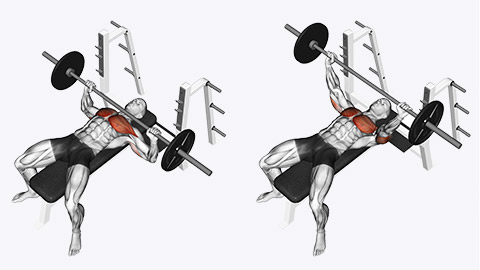
The following table provides information on the major muscles, variations, and equipment options.
| Major muscles | Variations/progressions | Equipment options |
|---|---|---|
|
Pectoralis major Anterior deltoid Triceps Serratus anterior |
Incline (activates upper fibers of pecs) Decline (activates lower fibers of pecs Flat (activates middle fibers of pecs) Vary grip width (closer grip isolates central part of pecs; while a wider grip isolates lateral part of pecs) |
Barbell Machine Swiss ball Bands Dumbbells |
Key coaching points and steps
- Lie faceup on a horizontal bench, with five points of contact.
- Adopt training posture (ensure safe lifting of the bar into starting position).
- Grasp the barbell with an overhand grip slightly wider than shoulder-width and maintain a flat back.
- Review training posture (ensure this is in place before repetitions begin).
- Inhale and lower the bar to the chest with a controlled movement.
- The barbell should follow a slightly arched movement, from chin line to nipple line and back.
- Exhaling, extend the arms moving the barbell from nipple to chin (opposite movement to above). Avoid locking elbows at the end of the eccentric phase, keep elbows 'soft'.
- Review training posture and adjust where required before the next repetition.
Note the safety precautions for this exercise.
Bench presses and pain
Elbow and wrist pain most often develop after bench pressing. This is something you as the personal trainer can help a client avoid by observing the following recommendations.
- This overuse injury is generally related to excessive training with long sets. In bench pressing, locking the elbows at extension can cause rubbing and microtrauma which will lead to inflammation and pain.
- At the first sign of elbow pain, avoid exercises that involve arm extension for several days and ice. If you (or the client) keep working out with this condition you may get intra-articular calcifications which may need surgery to fix!
- Some people will also get wrist pain with narrow grips depending on your (or the client’s) physical structure. Check posture to ensure wrists are straight during all stages of the movement, using a wider grip can often ease the pain. Excessive benching can also form muscular imbalances between the front and back of the shoulder.
- Overdeveloped anterior shoulders will cause the humerus (upper arm bone) to pull back against its shoulder socket joint. You must balance pressing exercises out with overhead presses and rotator cuff work. Observe that elbows are not passing the rib cage when performing the end movement, this would cause excessive straining on the shoulders. Ensure movement ends where elbows stop slightly above the line of the shoulder socket.
Incline bench press
Just like the standard benchpress but the bench is set at an angle. Typically incline benches are fixed however adjustable machines present options of angles, 45 degrees is generally a good rule of thumb although an adjustable machine can range from 30 to 75 degrees and will depend on factors such as height, muscle focus, and body type.
If doing an incline, use angle of 45-60°, and with a decline use angle of 20-40° approx. Note the safety precautions for this exercise.
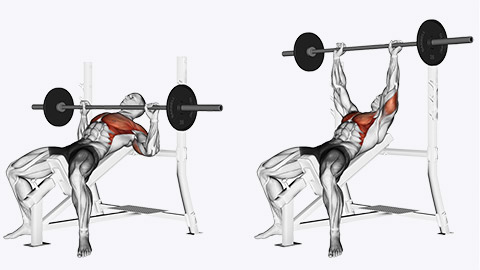
The following image shows a machine bench press.
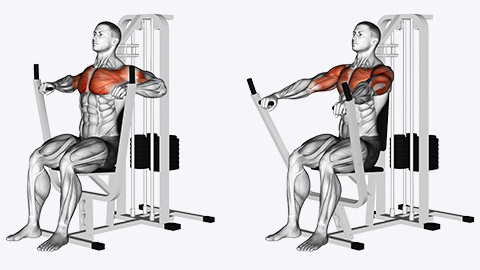
The following table provides information on the major muscles, variations, and equipment options.
| Major muscles | Variations/progressions | Equipment options |
|---|---|---|
|
Pectoralis major Anterior deltoid Triceps Serratus anterior |
Incline (activates upper fibers of pecs) Decline (activates lower fibers of pecs Flat (activates middle fibers of pecs) Vary grip width (closer grip isolates central part of pecs; while a wider grip isolates lateral part of pecs) |
Barbell Machine Swiss ball Bands Dumbbells |
Key coaching points and steps
- Sit within the frame of the machine, with five points of contact - feet, glutes, shoulders, head, hands.
- Adopt training posture (ensure safe lifting of the bar into starting position).
- Grasp the handles offered by the machine in an overhand grip style. Ensure the starting position of the machine enables the line of the hands to be in line with the nipples, this may mean adjusting the seat of the machine to achieve this before you begin. this creates the same movement pattern as on a bench whilst performing the exercise on the machine, as is, the movement pattern required to achieve maximal pec major input
- Review training posture (ensure this is in place before repetitions begin).
- Inhale and push the handles away from the chest in a controlled movement.
- The handles should follow a slightly arched movement, from chin line to nipple line and back.
- Exhaling, extend the arms moving the barbell from nipple to chin (opposite movement to above). Avoid locking elbows at the end of the eccentric phase, keep elbows 'soft'.
- Review training posture and adjust where required before the next repetition.
Like with the bench press, and incline bench press, elbow and wrist pain can develop after using a machine bench press. Follow the recommendations discussed for bench presses and pain.
There are 5 contact points to maintain:
- Feet: Have feet firm placed on the ground of another even surface such as a small step-up bench or platform to have ankles in line with knees and knees in line with hips for a stable and secure lower body posture.
- Glutes: Keep the glutes in contact with the bench throughout the exercise to ensure the lower back muscles only support the exercise and not performing the exercise.
- Shoulders: to keep the shoulder blades (scapula) safe and secure throughout the exercise, the best position to maintain is to fully retract and depress the scapula to begin and ensure this is maintained throughout the exercise. A handy way to describe this movement is to think of putting the shoulder blades "back in your pocket", squeezing them together and pushing them down.
- Head: The safest placement of the head, to take care of the cervical spine, is to ensure the head remains on the bench throughout the movement.
- Hands: Hands should be placed symmetrically along the bar with the middle of the head as an imaginary midline. Varying the angle will alter the contribution of different muscles and the gains achieved from the exercise and place different demands upon the ligaments and tendons around the joints (wrist, elbow, and shoulders) keep this in mind when selecting and supervising exercises for your clients, consider variations carefully in relation to your client's goals and abilities.

The following table provides information on the major muscles, variations and equipment options.
| Major muscles | Variations/progressions | Equipment options |
|---|---|---|
|
Pectoralis major Anterior deltoid Triceps Serratus anterior |
Incline (activates upper fibers of pecs) Decline (activates lower fibers of pecs Flat (activates middle fibers of pecs) Vary grip width (closer grip isolates central part of pecs; while a wider grip isolates lateral part of pecs) |
Dumbbell Machine Swiss ball Bands |
Key coaching points and steps
- Lie faceup on a horizontal, incline, or declined bench, with five points of contact.
- Adopt training posture (ensure safe lifting of the bar into starting position).
- Grasp the dumbbells with an overhand grip slightly wider than shoulder-width and maintain a flat back.
- Review training posture (ensure this is in place before repetitions begin).
- Inhale, with dumbbells inline with nipples, push dumbbells away from the body in an arch (from nipples to chin).
- Dumbbells should follow a slightly arched movement, from nipple line to chin line and back.
- Exhaling, extend the arms moving the dumbbell from chin line to nipple line (opposite movement to above). Avoid locking elbows at the end of the eccentric phase, keep elbows 'soft.
- Review training posture and adjust where required before the next repetition.
Like with the bench press, elbow and wrist pain can develop after the chest press. Follow the recommendations discussed for bench presses and pain.
Be mindful of the different demands upon the ligaments and tendons around the joints in relation to movement patterns and angles at the elbows and wrists and shoulders when selecting and supervising exercises for your clients, consider variations carefully in relation to your client's goals and abilities.
A standard push-up is illustrated in the following image.
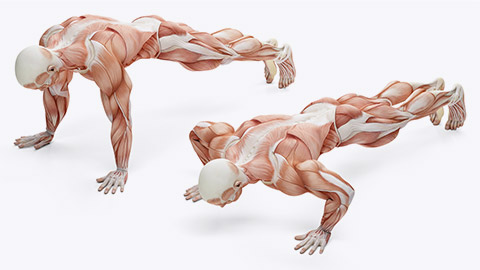
The following table provides information on the major muscles, variations and equipment options.
| Major muscles | Variations/progressions | Equipment options |
|---|---|---|
|
Pectoralis major Anterior deltoid Triceps |
Flat Incline (isolates inferior part of pecs) Decline (isolates clavicular head of pecs) Vary grip width (hands wider isolates lateral part of pecs; hands closer isolates the sternal head of pecs) |
Body weight BOSU or stability trainer External weights (i.e. weight vest) |
Key coaching points and steps
- Support yourself facedown on the ground, with arms extended, hands shoulder-width (or more) apart, and feet touching or slightly apart.
- Adopt training posture.
- Consider the body one solid piece (that is, everything moves as one unit).
- Inhale and bend the elbows to bring the chest close to the ground without arching the lower back excessively.
- Push back up to complete arm extension (maintain 'soft' elbows, that avoid locking elbow joints)
- Exhale at end of the movement.
- Review training posture and adjust where required before the next repetition.
Pec flies are illustrated in the following image.

The following table provides information on the major muscles, variations and equipment options.
| Major muscles | Variations/progressions | Equipment options |
|---|---|---|
|
Pectoralis major Anterior deltoid |
Incline/decline bench Rotating arm with ascent/decent |
Dumbbells Cables Bands |
Key coaching points and steps
- Lie on a narrow bench that won’t interfere with the shoulder movement and hold a dumbbell in each hand with arms extended and slightly bent to relieve stress on the joint.
- Adopt training posture.
- Inhale and open the arms to horizontal ensuring the elbows do not pass the line of the nipples/rib cage.
- Raise the arms to vertical while exhaling.
- Perform a small isometric contraction at the end of the movement to emphasize the work on the sternal head of pecs
- Review training posture and adjust where required before the next repetition.
Note:
- Never perform this lift with heavy weights.
- Be mindful of the different demands upon the ligaments and tendons around the joints (wrist, elbow, and shoulders).
Cable crossover flies are illustrated in the following image.

The following table provides information on the major muscles, variations, and equipment options.
| Major muscles | Variations/progressions | Equipment options |
|---|---|---|
|
Pectoralis major Anterior deltoid |
Change angle of pull (adjust height of cable) Change torso angle |
Cable machine Bands |
Key coaching points and steps
- Stand with legs slightly apart and lean the torso forward a bit, with arms spread apart and elbows slightly bent.
- Engage training posture.
- Inhale and squeeze the arms together until the wrists touch, maintaining training posture throughout the movement.
- Exhale at the end of a contraction.
- Squeeze pecs at end of the movement.
- Review training posture and adjust where required before the next repetition.
Note:
- You can work all the fibres of the pecs by varying the angle of the chest and the working angle of the arms.
- This exercise also works the pectoralis minor, which stabilises the scapular and pulls it forward.
- For more advanced clients, the power stance of one foot slightly in front of the other can be adopted, as long as core and stabilisation can be maintained throughout the movement.
A pec deck is illustrated in the following image.
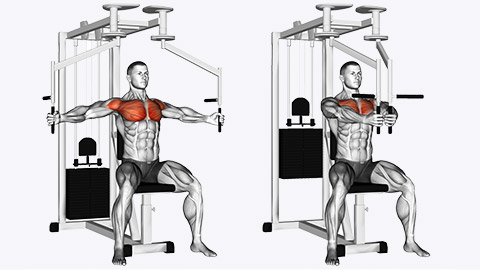
The following table provides information on the major muscles, variations and equipment options.
| Major muscles | Variations/progressions | Equipment options |
|---|---|---|
|
Pectoralis major Anterior deltoid |
Standing/seated Back against wall Vary grip (neutral/pronated) Lying facedown on an incline bench Cable machine |
Dumbbell Barbell Bands Cable machine |
Key coaching points and steps
This exercise works the pecs by stretching it.
- Sit on the machine, ensure the machine is set so hands begin in line with nipple line and feet are flat on the floor (aiming to have knee joint in line with ball and socket of hip i.e things at right angles to the floor).
- Adopt training posture.
- Sit on the machine with arms slightly behind the body, inhale and squeeze the arms together.
- Exhale at end of the movement.
- As the hands come together, focus the effort onto the sternal head of the pecs.
- Exhale at end of the movement.
- Review training posture and adjust where required before the next repetition.
Note:
- This exercise is good for beginners needing to develop enough strength to move on to more complex exercises.
- Ensure feet are flat on the floor and pointing forward. If a client has difficulty placing feet flat on the floor, adjust the seat. If further adjustment is required, consider using another flat surface, like a step-up bench placed under their feet while seated.
Various options for overhead/shoulder press are illustrated in the following images.
The following table provides information on the major muscles, variations, and equipment options.
| Major muscles | Variations/progressions | Equipment options |
|---|---|---|
|
Trapezius (upper fibers) Triceps Medial deltoid |
Standing/seated Dumbbell/barbell Alternating Shoulder rotation Front press |
Dumbbell Barbell (military press) Seated on Swiss ball/bench Machine |
Key coaching points and steps
- Sit on a bench, keeping the back straight, and hold dumbbells at shoulder level with an overhand grip.
- Adopt training posture.
- Inhale and extend arms vertically, gently touching weights above the crown of the head.
- Ensure elbows remain 'soft' at the end of the movement (that is, not 'locked').
- Exhale at end of the movement.
- In a controlled movement, return the elbows back to shoulder level.
- Review training posture and adjust where required before the next repetition.
Note: It is important to maintain the core, particularly during free weight-based exercises, to ensure the lower back is protected throughout the movement and decrease the risk of injury.
A front raise is illustrated in the following image.

The following table provides information on the major muscles, variations, and equipment options.
| Major muscles | Variations/progressions | Equipment options |
|---|---|---|
|
Anterior deltoid Pectoralis major (upper fibers) |
Standing/seated Back against wall Vary grip (neutral/pronated) Lying facedown on an incline bench Cable machine |
Dumbbell Barbell Bands Cable machine |
Key coaching points and steps
Cable frontal raise
- Stand with feet shoulder-width apart.
- Begin with hand(s) against the thighs or slightly to the side.
- Adopt training posture.
- Inhale and alternate raising the arms to the front to eye level.
- Exhale as the arm raises, in line with the shoulder (wrist, elbow, and shoulder in line with each other).
- In a controlled movement, bring the arm back to the resting position (in front of/slightly to the side of the thigh).
- Review training posture and adjust where required before the next repetition.
Note: Typically performed one arm at a time, alternating sides.
Dumbbell frontal raise
- Stand with feet slightly apart, holding the dumbbells with an overhand grip as they rest against the front of the thighs or slightly to the side.
- Adopt training posture.
- Inhale and alternate raising the arms in line with the shoulder (wrist, elbow, and shoulder in line with each other).
- In a controlled movement, bring the arm back to the resting position (in front of/slightly to the side of the thigh).
- Review training posture and adjust where required before the next repetition.
Note: All movements that raise the arms contract the muscles that anchor the scapula to the rib cage, such as the serratus anterior and rhomboids. This creates a stable support for the humerus to move from.
A lateral raise is illustrated in the following image.
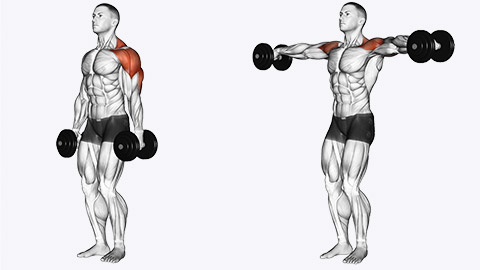
The following table provides information on the major muscles, variations and equipment options.
| Major muscles | Variations/progressions | Equipment options |
|---|---|---|
|
Medial deltoid Trapezius (especially if arms are lifted above parallel) |
Neutral grip Pronated grip Sitting/standing Cables |
Dumbbell Barbell Sitting on Swiss ball Bands Machine |
Key coaching points and steps
- Stand with a straight back, with legs slightly apart, arms hanging next to the body, holding a dumbbell in each hand.
- Adopt training posture.
- Inhale, raising the arms to horizontal with the elbows slightly bent.
- Aim to keep the arms slightly below shoulder height.
- In a controlled movement, return the arms back towards the side of the body by the thighs, exhaling as the arms descend.
- Return to the initial position.
- Review training posture and adjust where required before the next repetition.
Shrugs using dumbbells and barbells are illustrated in the following images.
The following table provides information on the major muscles, variations, and equipment options.
| Major muscles | Variations/progressions | Equipment options |
|---|---|---|
|
Trapezius (upper fibers) Deltoid |
Dumbbell Barbell Standing/seated Shoulder rotation |
Dumbbell Barbell Machine Bands |
Key coaching points and steps
- Stand with legs slightly apart (approximately shoulder width for stability), head upright and looking straight ahead, or slightly flexed forward, griping dumbbell at sides or barbell at front.
- Adopt training posture.
- Shrug the shoulders with an anterior-to-posterior rotation; keep the arms relaxed, back straight, and abdominals contracted.
- Return to the initial position.
- Review training posture and adjust where required before the next repetition.
Note: Heavy weights are not needed for this type of exercise, shoulders are slimmer muscles than others and do not require the same heavyweight when targeting this muscle group.
Shoulder pain when lifting
Note the safety precautions for this exercise. Most weightlifting injuries occur when training the deltoids and rarely result in muscle pulls or tears. They are usually caused by poor technique or overusing the tendons reinforcing the shoulder capsule.
When some people perform exercises where they raise the arms, such as extensions from behind the neck or lateral raises, the supraspinatus tendon is rubbed and compressed between the head of the humerus and the tendons originating from the collar bone (entrapment). Inflammation soon follows.
Some people have smaller distances between the humerus and these tendons, they will develop shoulder pain more regularly. These people should avoid behind-the-head extensions (including behind-head lat pulldowns) and lateral raises that go too high.
Another cause of shoulder pain is an imbalance in muscle tension around the shoulder ball and socket joint. Muscles hold the ball in the socket of this joint from in front, on top, and behind. If one or more gets tight or loose, the ball and socket joint will not line up correctly. This is a common cause of shoulder pain.
Pull-ups and assisted chin-ups are illustrated in the following images.
The following table provides information on the major muscles, variations, and equipment options.
| Major muscles | Variations/progressions | Equipment options |
|---|---|---|
|
Latissimus dorsi Trapezius (Middle fibers) Biceps Teres Major Rhomboids |
Hands neutral Hands pronated Hands supinated Vary grip width |
Pull up bar Assisted machine |
Key coaching points and steps
- Hang from a fixed bar generally with a shoulder-width wide overhand grip.
- Adopt training posture, maintain core, shoulders, and ensure elbows are fully extended, however, never locked.
- Inhale and pull chest up to the level of the bar (avoid a swinging movement for momentum).
- Exhale at the end of the movement.
- Lower the body in a controlled movement towards the ground, returning to starting position (keep elbows soft).
- Review training posture and adjust where required before the next repetition.
Note: To avoid tendinitis of the distal tendon of the biceps, keep elbows slightly bent.
Lat pull down with variations are illustrated in the following images.
The following table provides information on the major muscles, variations and equipment options.
| Major muscles | Variations/progressions | Equipment options |
|---|---|---|
|
Latissimus dorsi Trapezius (middle fibers) Teres major Biceps Rhomboids |
Hands neutral Hands pronated/supinated Vary grip width To front/back of the head |
Machine |
Key coaching points and steps
- Sit facing the machine with the legs under the pads, feet flat on the floor, pointing forward.
- Grip the bar with a wide overhand grip.
- Maintaining a straight back and engaged core, tilt back slightly from the hips with the upper body as one entire unit for complete lat engagement (and posture stabilisation)
- Inhale and pull the bar down to the sternal notch while slightly puffing out the chest and pulling elbows back.
- Exhale at the end of the movement.
- Review training posture and adjust where required before the next repetition.
Note:
- Avoid 'swinging' when lifting heavy weights in a lat pull down, if this occurs, lower the weight to a safe weight. If intensity needs to be increased, consider other techniques, such as slowing the movement.
- Keep shoulders in a retracted position throughout the lift to emphasize the lats.
- Adjust the machine where required to ensure pads support positioning on the machine. If feet cannot be placed evenly on the floor, adjust with a step-up bench or barbell plate or two.
- In both the lat pulldown and chin-ups, the long head of the triceps muscle is used to pull the upper arm towards the body’s centre line. Triceps injuries can occur during these lifts, so ensure sufficient warm-up and triceps stretching.
- Maintaining core stability and ensuring training posture is observed reduces the possibility of lumbar spine strain or injury.
Seated row is illustrated in the following images.
The following table provides information on the major muscles, variations and equipment options.
| Major muscles | Variations/progressions | Equipment options |
|---|---|---|
|
Latissimus dorsi Trapezius Rhomboids Posterior deltoid Biceps Erector spinae (if using back flexion/extension) |
Hands neutral grip Hands supinated/pronated grip Vary grip width With back flexion/extension |
Machine |
Key coaching points and steps
- Sit facing the machine, feet resting on the footpad and the torso bent forward.
- Sit far back enough so that knees remain slightly bent/'soft'.
- Adopt training posture, chin, shoulders, core with eyes and head looking straight ahead.
- From the hip, till the entire upper body back in a straight line (as one solid unit) a few degrees.
- Inhale and bring the handle to the base of the sternum by straightening back and pulling elbows back as far as possible.
- Actively pull shoulder blades together with each pull.
- Never round back with heavy weights.
- Exhale and control the weight moving away from your body (avoid being pulled by the weight).
- Review training posture and adjust where required before the next repetition.
Note:
- A rounded back typically implies too heavy a weight, so reduce the weight, and regain correct and safe training posture. If greater intensity is needed, consider the FITT principles; one adaptation would be slowing the speed of the movement to increase the intensity of the exercise.
- Allowing the weight to pull you back at the end of the movement risks smaller muscles taking the strain of a large weight.
One arm row using dumbbell is illustrated in the following image.
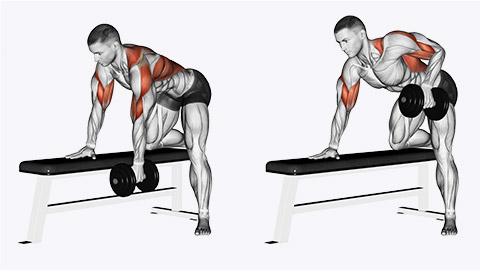
The following table provides information on the major muscles, variations and equipment options.
| Major muscles | Variations/progressions | Equipment options |
|---|---|---|
|
Latissimus dorsi Trapezius Posterior deltoid Bicep |
Vary pull angle |
Dumbbell |
Key coaching points and steps
- Using a gym bench, position on foot flat on the floor with ankle, knee, and hip joint in one line.
- Place the other leg, bent on the bench with the knee directly under the hip.
- Place hand on the bench with wrist, elbow, and shoulder in line.
- Grasp a dumbbell with the palm facing in (medially); using the opposite hand and knee on the bench to support the back and maintain posture.
- Adopt training posture, chin tuck (neck alignment), core, flat back.
- Inhale and lift the upper arm and elbow in a controlled movement as high as possible next to the body with the elbow bent. Keep back flat and abdominals contracted.
- Avoid swaying or twisting of the torso for a greater 'pull' and aim to keep posture fixed and steady.
- Exhale at end of the movement.
- Review training posture and adjust where required before the next repetition.
Note: Rotating the torso at the end of the movement, can on some occasions, be performed but it is important to highlight that this is an advanced movement and comes with safety risks so not advised for beginner exercisers or those with weaker core muscles. Proficiency in this movement pattern is required before introducing advanced techniques (as with all exercises).
Bent over row using a machine is illustrated in the following image.

The following table provides information on the major muscles, variations and equipment options.
| Major muscles | Variations/progressions | Equipment options |
|---|---|---|
|
Latissimus dorsi Trapezius Rhomboids Posterior deltoid Bicep |
Supinated or pronated grip Dumbbells for single arm isolation Vary grip width Angle of torso at different angles |
Dumbbells Barbells Bands T-bar |
Key coaching points and steps
- Stand with legs slightly bent, grasping the bar with an overhand grip and the hands wider than shoulder-width.
- Keep back straight, lean forward at 45° (so the bar is level with the top of the knee). Stick your bum back (sit into the movement similar to a partial squat) to get in the right position. However, ensure this does not knock out your core posture.
- Inhale and pull the barbell to the stomach, following the line of the thighs in a controlled, smooth movement.
- Exhale and return to the initial starting position, controlling the weight in line with gravity.
- Review training posture and adjust where required before the next repetition.
Upright rows using a cable machine and barbells are illustrated in the following images.
The following table provides information on the major muscles, variations and equipment options.
| Major muscles | Variations/progressions | Equipment options |
|---|---|---|
|
Trapezius (upper fibres) Deltoid Bicep |
Wide grip (uses deltoids more) Close grip (uses traps more) |
Dumbbells Barbells Plates Band Cable |
Key coaching points and steps
- Stand with legs slightly apart, keeping the back straight and grasping the bar or barbell with an overhand grip. For standard close grip have tips of thumbs from each hand touching.
- Adopt training posture.
- Inhale and pull the barbell up along the front of the body to chin (lower if needed) in a smooth and controlled movement, raising the elbows as high as possible.
- Always keep elbows higher than wrists and avoid excessive flexing of the wrists to prevent wrist pain.
- Do not rock your upper body excessively.
- Exhale and lower bar, controlling the weight in line with gravity.
- Review training posture and adjust where required before the next repetition.
Rear deltoid raises using dumbbells, cable machine, and seated machine are illustrated in the following images.
The following table provides information on the major muscles, variations, and equipment options.
| Major muscles | Variations/progressions | Equipment options |
|---|---|---|
|
Posterior (rear) deltoid Trapezius (lower fibres) Rhomboids Rotator Cuff muscles |
Seated Standing Machine Cables Bands |
Seated Standing Machine Cables Bands |
Key coaching points and steps
Adopt training posture and review before every repetition.
Seated
- Sit bent over at 45° with dumbbell under legs.
- Keep core activated, shoulders back and down, and a straight torso.
- Inhale and extend arms out to sides parallel with the ground. Ensure elbows are soft and do not come above shoulders.
- Exhale and lower the arms back towards the floor, returning to starting position.
Standing
- On two feet, move glutes back/sit into the position.
- Keep back straight or arched, bent over at the hips at approximately 45°.
- Inhale and extend arms out to sides till parallel. Ensure elbows are soft and do not come above shoulders.
- Exhale and lower the arms back towards the floor, returning to starting position.
Machine
- Sit on seat, feet flat on the floor with arms parallel to the ground out in front of you.
- Inhale and extend arms rearward through full range of motion. Maintain posture and soft elbows.
- Exhale and control the movement of the machine, leave a small gap between plates before the next repetition. Do not let the plates touch (or crash) until the set is over.
Cables
- Grab cable handles in each hand, cross hands (cables crossed) below, and in front of you.
- With an activated core and straight back, tilt the torso at a 45° angle (tilting from the hips).
- Inhale and straighten arms out to the side.
- Exhale and control the return of the weight with gravity.
Bicep curls using barbell (preacher bench), dumbbells (hammer curl), cable machine, and seated with dumbbell are illustrated in the following images.
The following table provides information on the major muscles, variations, and equipment options.
| Major muscles | Variations/progressions | Equipment options |
|---|---|---|
|
Biceps brachii Brachialis Brachioradialis |
Standing (try with back against the wall) Seated Preacher curls (isolates biceps well) Incline curls Reverse curls (good for strengthening weak wrists) Hammer curls (works brachioradialis muscle more) |
Dumbbell Barbell Band Machine Preacher bench |
Key coaching points and steps
- Whether standing or seated, begin the exercise with weights or barbell down at the side.
- Adopt training posture.
- Inhale and bend the elbow, bringing wrist(s) towards the shoulder until full flexion.
- Aim, with good posture, to avoid upper body movement, which creates momentum (thereby assisting the movement, decreasing work required from the bicep).
- Exhale and return to starting position, keeping elbows 'soft'.
- Review training posture and adjust where required before the next repetition.
Note:
- To avoid tendinitis and other elbow injuries, keep the elbow 'soft' when extended (that is, do not lock the elbow/fully extend the arm).
- To further target the brachioradialis muscle, rotate the forearm(s) at the elbow(s) before the forearm reaches fully horizontal.
The following illustration shows the different stances used to stabilise the body when training. These are appropriate for progressions (depending on the client's exercise ability). Compare the 'feet forward' vs 'feet together' stances.

Tricep pushdown/pulldown using a cable machine is illustrated in the following image.
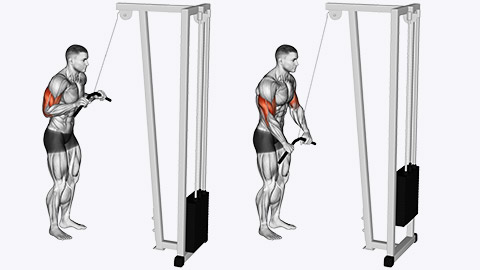
The following table provides information on the major muscles, variations, and equipment options for this exercise.
| Major muscles | Variations/progressions | Equipment options |
|---|---|---|
|
Triceps brachii (made up of long, medial, and lateral heads) |
One/two arm triceps pushdown with cable Supine (lying face upwards) triceps extension (BB or DB) Cable machine triceps extension Overhead triceps extension (DB or BB) Triceps kickbacks Rope pushdown (engages lateral head of triceps more) |
Ropes Dumbbell Bench Barbells Cable machines |
Key coaching points and steps
- Standing at a machine with feet shoulder-width apart, with feet either parallel to each other or one slightly in front of the other.
- Place your hands on the bar/pulley ropes using an overhand grip.
- Adopt training posture.
- Inhale and pull the bar/pulley ropes down towards your waist in a controlled movement, keeping elbows fixed by the side of the torso (imagine they are bolted there and can not move).
- Exhale, controlling the movement in line with gravity, returning to starting position.
- Keep elbows 'soft' at the end of the movement.
- Review training posture and adjust where required before the next repetition.
Note:
- The upper arm must remain securely by the side and not be allowed to travel excessively in order to isolate triceps.
- Using an underhand grip on cable pushdown exercises activates the medial head of the triceps more.
- Hold an isometric contraction at the end of the movement for 1-2 seconds to add intensity.
Tricep kickback using a dumbbell is illustrated in the following images.
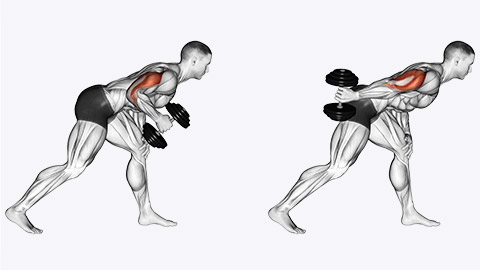
The following table provides information on the major muscles, variations, and equipment options for this exercise.
| Major muscles | Variations/progressions | Equipment options |
|---|---|---|
|
Triceps brachii (made up of long, medial, and lateral heads) |
Triceps kickbacks Rope pushdown (engages lateral head of triceps more) |
Ropes Dumbbell Bench |
Key coaching points and steps
Bench (dumbbells)
- Using a gym bench, position on foot flat on the floor with ankle, knee, and hip joint in one line.
- Place the other leg, bent on the bench with the knee directly under hip.
- Place hand on the bench with wrist, elbow, and shoulder in online.
- Grasp a dumbbell with the palm facing in (medially) and use the opposite hand and knee on the bench to support the back and maintain posture.
- Adopt training posture, chin tuck (neck alignment), core, flat back.
- Inhale and extend the arm at the elbow in a controlled movement keeping the elbow soft at the end of the movement. Keep back flat and abdominals contracted.
- Avoid swaying or twisting of the torso, aim to keep posture fixed and steady.
- Return the dumbbell to starting position ( elbow at an approximate 90-degree angle)
- Exhale at end of the movement.
- Review training posture and adjust where required before the next repetition.
Standing (dumbbell)
- Stand with legs slightly bent, one foot in front of the other, shoulder-width apart with dumbbell in hand, palm facing medially.
- Keep back straight, lean forward at the hips to approximately 45°, maintaining training posture.
- Inhale and extend the arm at the elbow in a controlled movement keeping the elbow soft at the end of the movement. Keep back flat and abdominals contracted.
- Avoid swaying or twisting of the torso, aim to keep posture fixed and steady.
- Exhale at end of the movement.
- Review training posture and adjust where required before the next repetition.
Note:
- The upper arm must remain securely by the side and not be allowed to travel excessively in order to isolate triceps.
- Using an underhand grip on cable pushdown exercises activates the medial head of the triceps more.
- Hold an isometric contraction at the end of the movement for 1-2 seconds to add intensity.
Tricep extensions using cambered bar (bent barbell) and dumbbells (seated and standing) are illustrated in the following images.
The following table provides information on the major muscles, variations, and equipment options for this exercise.
| Major muscles | Variations/progressions | Equipment options |
|---|---|---|
|
Triceps brachii (made up of long, medial, and lateral heads) |
One/two arm triceps pushdown with cable Supine (lying face upwards) triceps extension (BB or DB) Cable machine triceps extension Overhead triceps extension (DB or BB) Triceps kickbacks Rope pushdown (engages lateral head of triceps more) |
Ropes Dumbbell Bench Barbells Cable machines |
Key coaching points and steps
Seated - bench (dumbbells or barbell)
- Using a gym bench, seated comfortably on the edge with feet flat on the floor with ankle, knee, and hip joint in one line.
- Grasp a dumbbell, placed between both hands, with the palms facing up (supine) in an overhead position, mindful of the angle of shoulder joints, and excessive strain.
- Adopt training posture, chin tuck (neck alignment), core, flat back.
- Inhale and flex the arm at the elbow in a controlled movement allowing the barbell to lower behind the head. Keep back flat and abdominals contracted.
- Avoid swaying or twisting of the torso, aim to keep posture fixed and steady.
- Return to dumbbell to starting position via extending the elbows whilst exhaling.
- Review training posture and adjust where required before the next repetition.
Note:
- If using a barbell, ensure the elbows stay in line with each other and avoid them "flaring out"
- If performing in the supine position on a bench, ensure 5 points of contact are maintained. Aim to lower the barbell towards the forehead (without touching the forehead) and then extend the arms back to straight arms with soft elbows.
- The upper arm must remain securely by the side and not be allowed to travel excessively in order to isolate triceps.
- Using an underhand grip on cable pushdown exercises activates the medial head of triceps more.
- Hold an isometric contraction at the end of the movement for 1-2 seconds to add intensity.
Bench dips and dips using various machines are illustrated in the following images.
The following table provides information on the major muscles, variations, and equipment options for these exercises.
| Major muscles | Variations/progressions | Equipment options |
|---|---|---|
|
Triceps |
From bench From dip handles From ground Machine assisted |
Bench Machine (weighted and assisted) |
Key coaching points and steps
Bench
This exercise can be performed using one bench (two benches is an advanced progression).
- Sitting on the edge of a bench, place your palms on the edge with fingers wrapping underneath the bench.
- Adopt training posture.
- With elbows soft and firmly by the side of the torso, gently side off the bench.
- Inhale and control the body moving towards the floor in a controlled movement.
- Stay as close to the bench as possible and avoid increasing the angle between body and bench (imagine the back running up and down the edge of the bench during the movement).
- Exhale, pushing through the palms of the hands, elbows remaining firmly by the side of the torso (watch for elbows 'flaring' away from the body wings).
- Raise the body, extending the arms at the elbow keeping elbow 'soft' at the end of the movement.
- Review training posture and adjust where required before the next repetition.
Machine
- With the arms straight, arms and soft elbows grip onto the dip handles.
- Suspend body between two dip handles, feet off the ground (either via knees bent on assisted machine or knees bent with legs behind).
- Inhale and lower the body towards the ground via flexing at the elbows (avoid elbows moving higher than shoulders).
- Exhale and, pushing through the hands, keeping wrists straight, push the body away from the ground (keeping elbows soft at the end of the movement).
- Review training posture and adjust where required before the next repetition.
Note:
- This exercise works the triceps and lower fibres of pectorals as well as the anterior deltoid.
- Resting weights on top of thighs or wearing a weight vest increases the difficulty of the dip.
Wrist/forearms extension using a barbell is illustrated in the following image.
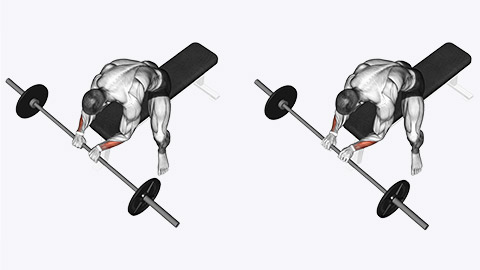
The following table provides information on the major muscles, variations, and equipment options for wrist flexors.
| Major muscles | Variations/progressions | Equipment options |
|---|---|---|
| Wrist flexors | Sitting Kneeling |
Dumbbells Barbells Bands |
Key coaching points and steps
- Hang wrist over knee or bench end, with the remainder of the forearm firmly on the bench or knee.
- Hold dumbbells or barbells in hand with an overhand grip.
- Inhale and extend wrists in a controlled movement.
- Exhale, return to starting position (neutral/level) wrist.
- Avoid heavy weights with this exercise, wrist flexors are a small muscle group therefor need low weights to avoid strain or injury.
- These exercises strengthen the wrists, which are often vulnerable because of weak wrist extensors or flexors.
The following table provides information on the major muscles, variations, and equipment options for wrist flexors.
| Major muscles | Variations/progressions | Equipment options |
|---|---|---|
|
Wrist extensor |
Sitting Kneeling |
Dumbbells Barbells Bands |
Key coaching points and steps
- Hang wrist over knee or bench end, with the remainder of the forearm firmly on the bench or knee.
- Hold dumbbells or barbells in hand with an underhand grip.
- Inhale and flex wrists in a controlled movement, allowing the bar to slowly and steadily close to the tip of the fingers.
- Exhale, roll the weight, steadily, back into the palm, close your grip and return to starting position (neutral wrist).
- Avoid heavy weights with this exercise, wrist flexors are a small muscle group therefore need low weights to avoid strain or injury.
- These exercises strengthen the wrists, which are often vulnerable because of weak wrist extensors or flexors.
Note:
- Wrist extensors are the extensor carpi radialis longus and brevis, extensor digitorum, extensor digiti minimi, and extensor carpi ulnaris.
- Wrist flexors are the flexor carpi radialis, palmaris lonus, flexor carpi ulnaris and profundus.
Perform each core exercise, including progressions and regressions where possible. Talk through the cues and what muscles are being targeted. Consider how each exercise supports health and skill-based fitness components and training principles.
Complete the self-assessment on demonstrating upper body exercises. If you would like feedback, post in the forum.
Complete the self-assessment on explaining upper body exercises. If you would like feedback, post in the forum.
